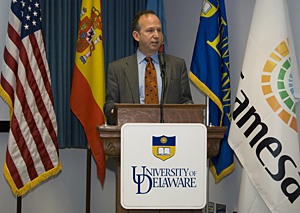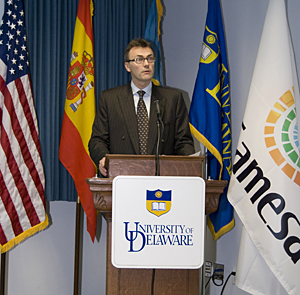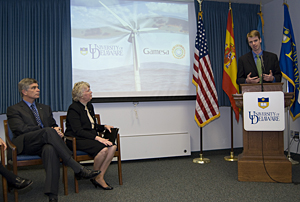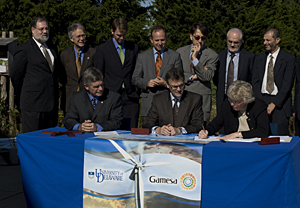



- Rozovsky wins prestigious NSF Early Career Award
- UD students meet alumni, experience 'closing bell' at NYSE
- Newark Police seek assistance in identifying suspects in robbery
- Rivlin says bipartisan budget action, stronger budget rules key to reversing debt
- Stink bugs shouldn't pose problem until late summer
- Gao to honor Placido Domingo in Washington performance
- Adopt-A-Highway project keeps Lewes road clean
- WVUD's Radiothon fundraiser runs April 1-10
- W.D. Snodgrass Symposium to honor Pulitzer winner
- New guide helps cancer patients manage symptoms
- UD in the News, March 25, 2011
- For the Record, March 25, 2011
- Public opinion expert discusses world views of U.S. in Global Agenda series
- Congressional delegation, dean laud Center for Community Research and Service program
- Center for Political Communication sets symposium on politics, entertainment
- Students work to raise funds, awareness of domestic violence
- Equestrian team wins regional championship in Western riding
- Markell, Harker stress importance of agriculture to Delaware's economy
- Carol A. Ammon MBA Case Competition winners announced
- Prof presents blood-clotting studies at Gordon Research Conference
- Sexual Assault Awareness Month events, programs announced
- Stay connected with Sea Grant, CEOE e-newsletter
- A message to UD regarding the tragedy in Japan
- More News >>
- March 31-May 14: REP stages Neil Simon's 'The Good Doctor'
- April 2: Newark plans annual 'wine and dine'
- April 5: Expert perspective on U.S. health care
- April 5: Comedian Ace Guillen to visit Scrounge
- April 6, May 4: School of Nursing sponsors research lecture series
- April 6-May 4: Confucius Institute presents Chinese Film Series on Wednesdays
- April 6: IPCC's Pachauri to discuss sustainable development in DENIN Dialogue Series
- April 7: 'WVUDstock' radiothon concert announced
- April 8: English Language Institute presents 'Arts in Translation'
- April 9: Green and Healthy Living Expo planned at The Bob
- April 9: Center for Political Communication to host Onion editor
- April 10: Alumni Easter Egg-stravaganza planned
- April 11: CDS session to focus on visual assistive technologies
- April 12: T.J. Stiles to speak at UDLA annual dinner
- April 15, 16: Annual UD push lawnmower tune-up scheduled
- April 15, 16: Master Players series presents iMusic 4, China Magpie
- April 15, 16: Delaware Symphony, UD chorus to perform Mahler work
- April 18: Former NFL Coach Bill Cowher featured in UD Speaks
- April 21-24: Sesame Street Live brings Elmo and friends to The Bob
- April 30: Save the date for Ag Day 2011 at UD
- April 30: Symposium to consider 'Frontiers at the Chemistry-Biology Interface'
- April 30-May 1: Relay for Life set at Delaware Field House
- May 4: Delaware Membrane Protein Symposium announced
- May 5: Northwestern University's Leon Keer to deliver Kerr lecture
- May 7: Women's volleyball team to host second annual Spring Fling
- Through May 3: SPPA announces speakers for 10th annual lecture series
- Through May 4: Global Agenda sees U.S. through others' eyes; World Bank president to speak
- Through May 4: 'Research on Race, Ethnicity, Culture' topic of series
- Through May 9: Black American Studies announces lecture series
- Through May 11: 'Challenges in Jewish Culture' lecture series announced
- Through May 11: Area Studies research featured in speaker series
- Through June 5: 'Andy Warhol: Behind the Camera' on view in Old College Gallery
- Through July 15: 'Bodyscapes' on view at Mechanical Hall Gallery
- More What's Happening >>
- UD calendar >>
- Middle States evaluation team on campus April 5
- Phipps named HR Liaison of the Quarter
- Senior wins iPad for participating in assessment study
- April 19: Procurement Services schedules information sessions
- UD Bookstore announces spring break hours
- HealthyU Wellness Program encourages employees to 'Step into Spring'
- April 8-29: Faculty roundtable series considers student engagement
- GRE is changing; learn more at April 15 info session
- April 30: UD Evening with Blue Rocks set for employees
- Morris Library to be open 24/7 during final exams
- More Campus FYI >>
1:19 p.m., Oct. 19, 2009----The University of Delaware and Gamesa Corporación Tecnológica have finalized an agreement to install a utility-scale 2-megawatt Gamesa wind turbine at UD's Hugh R. Sharp Campus in Lewes in 2010.
UD and Gamesa representatives signed the agreement in an Oct. 19 ceremony attended by several dignitaries, including Delaware Gov. Jack Markell, Delaware Department of Natural Resources and Environmental Control Secretary Collin O'Mara, and City of Lewes Mayor Jim Ford.
Project partners anticipate the land-based campus turbine to stand approximately 400 feet high from its tower base to the apex of its blade at peak rotation. Each of the turbine's three blades will be approximately 140 feet long. Based on input from state regulators and a desire to minimize environmental impacts, UD and Gamesa intend to locate the turbine on land to the north and west of campus buildings. Final details about size and location will be determined following additional meetings with regulators and the public.
UD President Patrick Harker, one of the signers of the agreement, said, “The University of Delaware is thrilled to partner with Gamesa on wind power research and technology. Today, we celebrate Delaware's leadership in sustainable energy, and pave the way for even greater collaboration and even bigger plans in the years ahead.”
A typical 2-MW turbine provides enough emissions-free electricity to power about 500 average homes, so the single turbine is expected to provide clean, carbon-free electricity for the entire campus, which is part of UD's College of Earth, Ocean, and Environment (CEOE). As a result of this agreement, project partners anticipate the campus to have 100 percent of its electricity provided by wind power, thus meeting all its electricity needs with no net carbon emissions and making it a model for other institutions in the nation.
“We are excited to be able to reduce our carbon footprint at the Lewes campus and at the same time undertake research on and provide educational opportunities for a technology that will be part of tomorrow's economy,” said CEOE Dean Nancy Targett.
UD officials chose wind power to meet its commitment to reduce its carbon footprint due to the favorable winds in the coastal area of Lewes. At times, the turbine is expected to generate more than enough power for the campus; the excess will be fed to the electric grid for use by others in Lewes.
Markell said, “Delaware has made clear that the health of our economy and the health of our environment can be intertwined. We can, and will, put more people to work while creating a more sustainable environment in which to live. Centers of innovation such as the University of Delaware and Gamesa, through their own work and partnerships like this turbine, will only enhance Delaware's growing reputation as a leader in clean technology.”
In addition to providing carbon-free electricity generation, the project will enhance the two parties' research in areas such as turbine corrosion, avian impacts, and policy issues related to renewable energy. Information gained from the project will help the University and Gamesa establish the first offshore wind turbine in the Americas in 2011 or 2012.
“Gamesa's turbines can help to create a stronger economy, a safer world, and a cleaner environment by harnessing the wind to generate homegrown energy with zero emissions,” said Dirk Matthys, CEO of Gamesa North America, who participated in the ceremony along with Chief Corporate Officer Luis Miguel Fernandez. “We are excited about the opportunity to work with the University of Delaware and its students to reshape America's energy future. This partnership fits perfectly with our 'energy culture' ethos and positions Gamesa to remain the world's leader in wind energy technology.”
Targett and CEOE professors Jeremy Firestone and Willett Kempton conceived the project. Firestone and Kempton have studied the amount of power supplied by Delaware's offshore winds as well as public reaction to and policies for wind-energy use.
Gamesa and UD have a long-standing relationship. In March 2008, for example, more than 20 students and faculty from UD's College of Engineering toured Gamesa's manufacturing facility at the Keystone Industrial Port Complex in Fairless Hills, Pa., where the company makes the nacelles that sit atop a turbine's base tower. Nacelles contain mechanical gears as well as the turbine generator, transformer, power conversion equipment, and control equipment.
UD and Gamesa expect the wind turbine to be in operation and generating electricity in the spring of 2010.
About the University of Delaware
The University of Delaware, the flagship institution of the state of Delaware, is one of the oldest Land Grant institutions in the nation, and one of only three institutions to also have Sea Grant and Space Grant status. The university is classified by the Carnegie Foundation for the Advancement of Teaching as a research university with very high research activity -- a designation accorded fewer than 3 percent of U.S. colleges and universities. The university is a state-assisted, privately controlled institution with an enrollment of more than 16,000 undergraduates, 3,500 graduate students and 1,000 professional and continuing study students.
About Gamesa
Gamesa specializes in sustainable energy technologies, mainly wind power. Gamesa is the market leader in Spain and is positioned among the most important wind generator manufacturers in the world.
With an international workforce of some 7,000 employees, including 900 in the United States, Gamesa has installed over 16,000 megawatts of its main product lines in 20 countries over four continents. Gamesa has built or sold nearly 2,000 megawatts in wind turbines in the United States since 2003.
Total production amounts to more than 5.45 million tons of petroleum equivalent per year and prevents the emission into the atmosphere of more than 34 million tons of carbon dioxide a year, helping to reduce the harmful effects of global warming.
Headquartered in Spain, Gamesa is publicly traded on the Spanish stock exchange and included among others in the Dow Jones and FTSE4GOOD sustainability indexes. Gamesa also has production centers in Europe, China, and the United States.
Photos by Lisa Tossey


